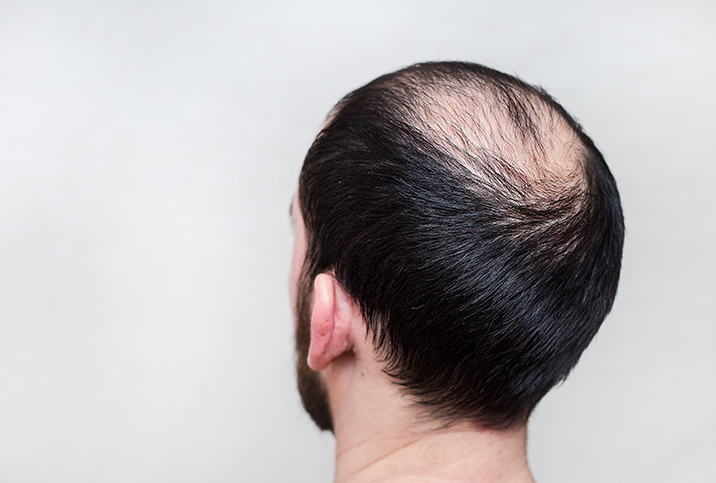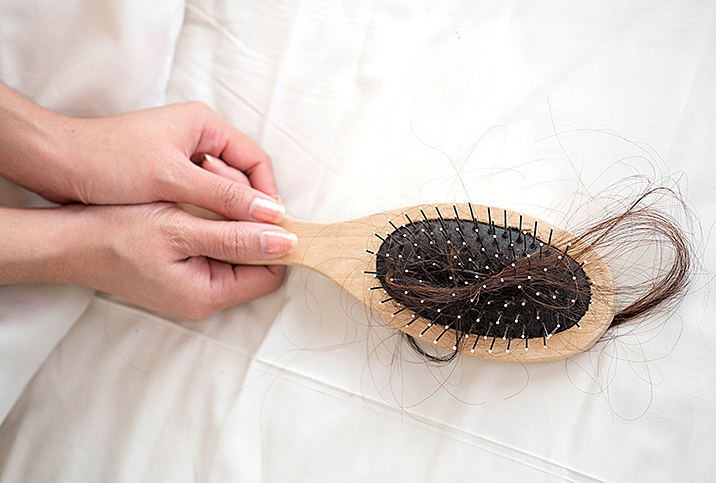The Skinny on Thinning Hair

We all have moments of doubt when we look at the hair left behind on the brush or around the shower drain, wondering if there's enough left on our heads.
The average person loses between 50 and 100 hairs each day from all over their bodies. Though this may seem like a lot, it typically isn't an issue because new hair is continually replacing any that falls out. The problem of hair loss begins when new hair growth doesn't keep up with the shedding.
Hair loss can generally be divided into two categories: temporary and permanent.
"Following a high fever or stress, a chronic infection or viral illness, one may experience noticeable hair loss," said Elizabeth Mullans, M.D., a board-certified dermatologist in Houston, giving an example of temporary hair loss. "This problem is real and is called telogen effluvium and can last for six to nine months before it stops and takes at least three to four months to return to normal."
Other causes of temporary hair loss include:
- Chemotherapy
- Medication for blood pressure and gout
- Hairstyles that pull at the roots, such as tight ponytails and braids
- Repeated and excessive use of harsh chemicals
- Low levels of vitamin D and iron deficiencies
- Restrictive diets and rapid weight loss
- An abnormal thyroid
- High doses of vitamin A
While hair usually grows back on its own, Mullans recommended taking a daily vitamin supplement with biotin—often marketed as hair and nail vitamins—to curb hair breakage and also grow healthy hair from the get-go.
She also suggested being mindful of ingredients in hair products and taking steps to maintain a healthy scalp.
"In general, it's best to avoid products with sulfates and parabens and anything that could clog up your follicles, like the overuse of dry shampoo," Mullans said. "It's also a good idea to do a regular scalp exfoliation to help clear it of debris and buildup."
A genetic connection
The most common type of hair loss in both men and women is also the most unavoidable: hereditary baldness. Known as androgenic alopecia, the condition causes hair follicles to shrink and eventually stop producing hair. This shrinking can begin in your teen years but often starts later in life.
For men, the first sign is usually a receding hairline or a bald spot on top of the head, while women experience an overall thinning or widening part of the hair.
"Another reason we have hair loss is from an autoimmune condition called alopecia areata that attacks the hair follicles," said April Moreno, Ph.D., M.P.H., founder and CEO of the Autoimmune Community Institute, a research, advocacy and support organization in San Diego. "With autoimmune diseases, our immune system doesn't understand the difference between an invader and our bodies—we attack our own bodies and systems."
The effects of alopecia areata (AA) can range from loss and regrowth of patches of hair to complete loss of hair over the entire body. While there is no cure for AA, hair may grow back on its own or as a result of treatment with corticosteroids or minoxidil.
Restoring your mane
A variety of therapies can stimulate the regrowth of hair, depending on the reason it fell out in the first place.
Corticosteroids, or steroids, as they are more commonly known, are sometimes used to treat alopecia areata. Available as a topical treatment or injection, they suppress the immune system, allowing hair to grow.
Minoxidil, best known by the brand name Rogaine, is known to help with certain types of hair loss by encouraging growth, strengthening strands and stimulating hair follicles.
Platelet-rich plasma (PRP) is one of the newer options for treating hair loss. A physician isolates the plasma and platelet proteins in a patient's blood, and injects both of them into the scalp where hair is thinning.
Low-level LED laser light, also known as red light therapy or cold laser therapy, promotes circulation and encourages follicles to grow hair.
Surgical hair replacement tends to be a more appropriate solution for men because their hair loss typically occurs in larger areas, whereas women tend to experience overall thinning. The procedure is costly and comes with some discomfort, and a botched job can be difficult and costly to repair, so it's essential to choose a hair restoration specialist carefully.
"Choose a physician who practices hair restoration exclusively, as they are more likely to produce results that look natural and are unnoticeable," Mullans recommended.
Other factors to consider when selecting a physician to restore your hair include:
- How long they have been in practice
- How many procedures they have performed
- Whether they are fellowship-trained and board-certified
- Whether they provide names of previous patients and "before and after" photos of their work.
To FUT or FUE?
You also want to choose a physician who is experienced in both hair transplant methods—follicular unit transplantation (FUT) and follicular unit extraction (FUE)—so they can choose the method best suited for your needs.
Both techniques relocate active follicles from the back of the scalp to areas where hair is thinning. With FUT, the physician removes a strip of skin with hair follicles from the donor site, usually the back of the head, where hair is naturally fuller. Small sections of tissue containing hair follicles are separated from the strip and individually placed into tiny holes in the area of the scalp where balding is taking place. The downsides of follicular unit transplantation include a horizontal scar across the back of the head where the original strip was removed and a potentially lengthy recovery time.
The FUE technique provides equivalent results with fewer disadvantages. Rather than removing a strip of skin from the back of the head, the physician removes individual follicles directly from the scalp and inserts them into tiny incisions made into the recipient site. While surgery time is longer, FUE requires a shorter recovery time and results in less post-procedure discomfort.
While the reasons for hair loss are many, so is the variety of potential treatments. Speak to your physician so you can understand the reason for the loss of your locks and the appropriate steps to take to restore your mane to its former glory.


















